My Incline Press-Windmill Routine for Arms
Guest Article By: Bill Brian
1998 World Masters Champion, 50-54 years,
+105kg Class
Originally posted April 21st, 1999
I offer my arm/shoulder routine for those who want stronger arms
and shoulders. This workout also helps prevent/rehabilitate shoulder problems.
I am so pleased with the results that I still find it hard to believe that
it works so well. Over the last 30 years, I have tried a lot of arm routines,
but this one is the best. The windmills are the primary exercise. I have
a dedicated arm day once a week and work the arms to near exhaustion. It
takes a good 45 minutes or more.
INCLINE PRESSES: I start with incline presses on a 45 degree bench.
I use it because there are no steeper ones. But it seems to be a good angle.
Yesterday I did the following sets/weights: 45x3, 115x3, 185x3, 235x3,
265x3, 275x3, 285x2, 290x3, 255x5, 255x5. I have been doing incline presses
for about 4 months, having started with about 225. Prior to this, I only
did windmills over the last 4 years. I started inclines again to vary my
routine, and continued with them when I found they do not hurt my shoulders.
WINDMILLS: Next I do the windmills on a flat bench with dumbells
(works like a swimming back stroke-10 reps in the Biceps direction-then
reverse the rotation and do 10 reps in the Triceps direction ). I injured
my shoulder so badly 4 years ago that I stopped doing full snatches and
have done only power snatches since then. The windmills have helped me
rebuild/maintain my shoulders. I hope to try full snatches again in competition
if all goes well over the next 5 months. If you haven't tried windmills,
you can't possibly know how hard they are. They are great for stretching
the shoulders and building strength in all muscle groups of the shoulders
and arms. If I were a body builder, I would do them all the time because
they work so effectively. Once a week heavy should be enough for any olympic
lifter. They should be done lightly (5-15#) before every workout for stretching
the shoulders/avoiding rotator cuff injuries.
I only do the bicep set of 10 up to 25 pounds-it bulks up the biceps
too much for the olympic lifts if you do too much more:
Both Directions: 5#x10x2, 10x10x2, 15x10x2, 20x10x2, 25x10x2, Triceps
Only Direction: 30x10, 35x10, 40x10, 45x10, 50x10
Try to keep your arms straight with the weights as long as you can:
this really works the shoulders. As the weight gets heavier, you'll find
yourself doing tricep extensions and curls. By the end of the workout,
your biceps and triceps will be pumped. Because of this exercise, I have
never had bigger arms or shoulders than I do now.
OVERHEAD SQUATS. I am working on my snatch bottom position and arms/shoulder
strength and positioning using these. These are tough, but a great exercise.
Especially tough after a long arm workout. The point is to be able to do
these when you are tired so that you really work on exercising control
and getting into position.
MILITARY PRESSES: If I am ambitious, I sometimes finish my workout
with military presses. I find that these are actually easy to do when I
am warmed up from Inclines and windmills. I jump quick and burn out quick
however. I usually work up to around 265-285 for single or a double. I
usually do rack jerks on another day.
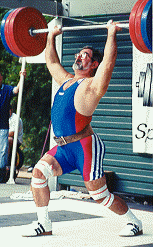
Bill jerking 363 lbs at the
2000 Bad Mother Open.
Unfortunately, even though he
succeeded, the lift was red lighted.
NOTE: Bill succesfully C&J'd 370 lbs.
at the 2000 World Masters Championships.
The highest official weight lifted by a man over 50.
__________________________________________________
WINDMILLS ILLUSTRATED
By: J.V. Askem
NOTE: When starting a new exercise, always proceed with caution using
light weights. On willmills, dumbbells are the implements of choice. However,
if your dumbbells don't go low enough in weight, a pair of 2 1/2 lb or
5 lb plates will suffice.
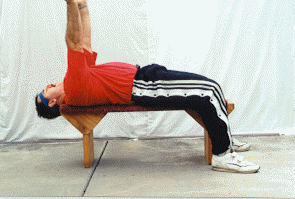 Step 1: Start with two dumbbells pressed up at arms length with
your palms facing each other.
Step 1: Start with two dumbbells pressed up at arms length with
your palms facing each other.
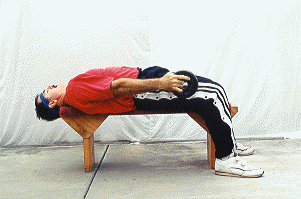 Step 2: With your arms straight or slightly bent, lower the weights
down towards your legs.
Step 2: With your arms straight or slightly bent, lower the weights
down towards your legs.
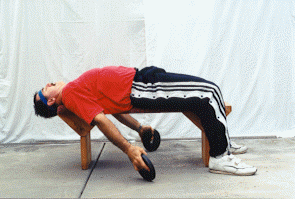 Step 3: Keep lowering the weights below the plane of the bench
until they touch the floor.
Step 3: Keep lowering the weights below the plane of the bench
until they touch the floor.
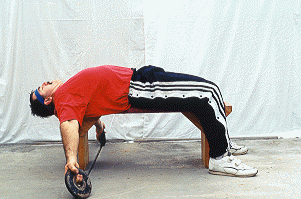 Step 4: While the weights are on the floor, or as low as you
can go, start rotating the weights back.
Step 4: While the weights are on the floor, or as low as you
can go, start rotating the weights back.
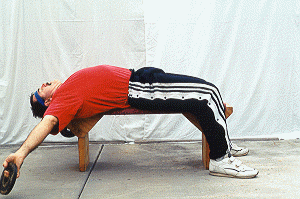 Step 5: Continue rotating the weights back until your hands align
with your body over your head. Always try to keep the weights in contact,
or as close to the floor as possible. Bend your arms if necessary to do
this.
Step 5: Continue rotating the weights back until your hands align
with your body over your head. Always try to keep the weights in contact,
or as close to the floor as possible. Bend your arms if necessary to do
this.
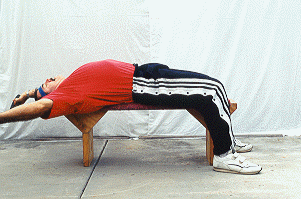 Step 6: When your hands are over your head, raise the weights
as on a bent arm pullover.
Step 6: When your hands are over your head, raise the weights
as on a bent arm pullover.
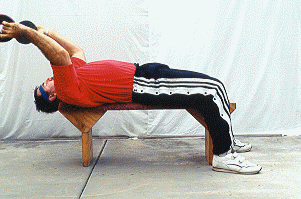 Step 7: Finish the movement by just extending your arms to pressed
locked out position.
Step 7: Finish the movement by just extending your arms to pressed
locked out position.
Step 8: At the finished position. The same position as step
1. Then repeat the steps 1 through 7 for 10 reps total. NOTE: To perform
windmills in the other direction, just follow steps 8 through 1 backwards.
FINAL NOTE: I've had several E mails from trainees who have
had good succcess doing windmills in the standing position. So it goes
to prove, "nothing is written in stone".
All the best with your training. JVA
RETURN
TO ASSISTANCE EXERCISES INDEX
TO THE
CABLE/ BAR GUY'S HOME PAGE







